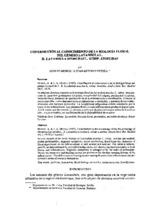Contribución al conocimiento de la biología floral del género Lavandula L. II: Lavandula stoechas L. subsp. stoechas. II
Contribution to the knowledge of the floral biology of the genus Lavandula L. II. La vandula stoechas L. subsp. stoechas. II
Autor
Devesa Alcaraz, Juan Antonio
Muñoz, Adolfo
Editor
Consejo Superior de Investigaciones Científicas, Real Jardín BotánicoFecha
1987Materia
FructificaciónSecreción de néctar
Lavandula
Biología floral
Protandria
Labiatae
METS:
Mostrar el registro METSPREMIS:
Mostrar el registro PREMISMetadatos
Mostrar el registro completo del ítemResumen
Several aspects of the floral biology of Lavandula stoechas L. subsp. stoechas are studied:
pollen germinability, stigmatic receptivity, néctar production, floral longevity, dymanics of
floral appearance on the inflorescences as well as fruit and seed set. The taxon is selfcompatible,
as demonstrated by controlled pollinations, and shows a marked protandry at both
flower and inflorescence. Stigmatic receptivity is anticipated by the visits of pollinators.
Néctar secretion rate and fruiting success are maximum for the first opening flowers of the
inflorescence. The differences in fruiting success among flowers of an inflorescence are discussed
in terms of resource limitations. Se estudian diversos aspectos de la biología floral de Lavandula stoechas L. subsp. stoechas, como la capacidad germinativa del polen, receptividad del estigma, producción de néctar, duración floral, dinámica de apertura floral en la inflorescencia y fructificación. El taxon es autocompatible, como demuestran las polinizaciones controladas, y presenta flores e inflorescencias con marcada protandria. La receptividad estigmática resulta anticipada por la visita de los polinizadores. Las primeras flores de cada inflorescencia producen mayor cantidad de néctar que las restantes y, además, son las que alcanzan un mayor índice de fructificación, lo que se explica por una limitación de la disponibilidad de recursos.

